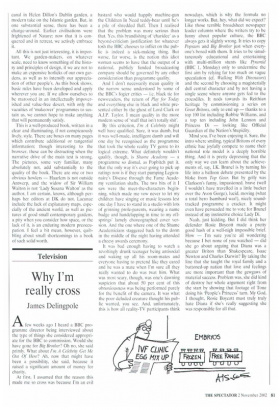Gardens
Timely overview
Ursula Buchan
Penelope Hobhouse is one of the bestknown contemporary British garden designers, who has built up an enviable reputation and practice on both sides of the Atlantic. But she is also a garden writer and, fostered by her time at Girton no doubt, something of a scholar. In 1992, she wrote the impressive Plants in Garden History; ten years later comes The Story of Gardening, published by Dorling Kinders
Icy at a very reasonable £25. Covering some of the same ground as the earlier book, but encompassing all the important movements in pleasure-garden design since records began, this is a book aimed at the general, interested, intelligent reader. It seems to me she has done us (if I may include myself in that number) a service.
Since the last important work on the subject — Christopher Thacker's The History of Gardens in 1979 — so much has happened to energise garden-history research that a new overview is timely. The Garden History Society, founded 30 years ago, is now a substantial and respected force, with a highly regarded journal, Garden History. In the United States, there is the equally respected Studies in the History of Gardens and Designed Landscapes. The extensive bibliography attests to Mrs Hobhouse's hard work; in what she calls her 'general garden history', she has climbed onto the shoulders of many admired scholars, such as John Harvey and John Dixon Hunt, in order to be able to describe the entire landscape to us. She could not have done it so well had she not been a practitioner in garden design, a difficult and often underrated artistic profession. (There are far more garden designers around than people who know how to design gardens.) Mrs Hobhouse's aim in this book is to trace the history of garden design in every country where influential gardens or styles have been developed. She begins at the very beginning, in about 4000 BC, with the oldest cuneiform tablets of the Mesopotamians. She explores the ancient concept of paradise and there is an intensely touching image of stone reliefs of Sennacherib's paradise garden outside Nineveh in the 7th century BC; as she points out, the depiction of 'paradise' as a garden predates all the main monotheistic religions. She goes on to describe Egyptian, Persian, classical Greek and Roman, Islamic, European, American, Chinese and Japanese ideas. She finishes at the absolutely latest minute with a discussion of contemporary minimalism.
What clearly fascinates the author is the lengths to which earlier civilisations went to overcome physical difficulties, such as lack of water, in order to make gardens, not just for utilitarian reasons of safety and fruitfulness, but for aesthetic, cultural and spiritual ones as well. In the process, it becomes clear to the reader just how eclectic is modern garden design, and just how unchanging have been the imperatives. It would seem that there are few truly new ideas under the sun, or ones that cannot be traced back in part to, say, the Islamic garden of the Alhambra, the Shinto gardens in ancient Japan or the 18th-century Landscape Movement. She points up the similarities between 20th-century Californian gardens, for example, and those discovered at Pompeii (43 BO. The last picture in the book is of the recently laid-out formal
canal in Helen Dillon's Dublin garden, a modern take on the Islamic garden. But, in one substantial sense, there has been a change-around. Earlier civilisations were frightened of Nature; now that it is conquered and in retreat, we actively embrace it.
Al] this is not just interesting, it is important. We garden-makers. on whatever scale, need to know something of the history and principles of design, if we are not to make an expensive horlicks of our own gardens, as well as to intensify our appreciation of other people's. As this book shows, basic rules have been developed and apply wherever you are, If we allow ourselves to be marooned in an intellectually impoverished and value-free desert, with only the vacuities of 'makeover' programmes to sustain us, we cannot hope to make anything that will permanently satisfy.
This is a well-produced book, written in a clear and illuminating, if not conspicuously lively, style. There are boxes on many pages which contribute additional or tangential information; though interesting to the browser, these can be distracting when the narrative drive of the main text is strong. The pictures, some very familiar, many absolutely not, add substantially to the quality of the book. There are one or two obvious howlers — Haarlem is not outside Antwerp, and the widow of Sir William Walton is not 'Lady Susana Walton' as the author, I am certain, knows, although perhaps her editors at DK do not. Lacunae include the lack of explanatory maps, especially of the ancient world, as well as pictures of good small contemporary gardens, a pity when you consider how space, or the lack of it, is an enduring modern preoccupation. I feel a bit mean, however, quibbling about small shortcomings in a book of such solid worth.



































































































 Previous page
Previous page